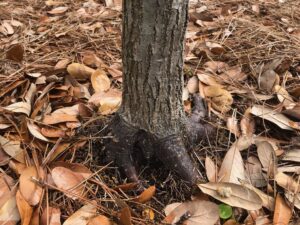Fall Leaf Litter Helps Pollinators and Builds Soil
go.ncsu.edu/readext?1100364
en Español / em Português
El inglés es el idioma de control de esta página. En la medida en que haya algún conflicto entre la traducción al inglés y la traducción, el inglés prevalece.
Al hacer clic en el enlace de traducción se activa un servicio de traducción gratuito para convertir la página al español. Al igual que con cualquier traducción por Internet, la conversión no es sensible al contexto y puede que no traduzca el texto en su significado original. NC State Extension no garantiza la exactitud del texto traducido. Por favor, tenga en cuenta que algunas aplicaciones y/o servicios pueden no funcionar como se espera cuando se traducen.
Português
Inglês é o idioma de controle desta página. Na medida que haja algum conflito entre o texto original em Inglês e a tradução, o Inglês prevalece.
Ao clicar no link de tradução, um serviço gratuito de tradução será ativado para converter a página para o Português. Como em qualquer tradução pela internet, a conversão não é sensivel ao contexto e pode não ocorrer a tradução para o significado orginal. O serviço de Extensão da Carolina do Norte (NC State Extension) não garante a exatidão do texto traduzido. Por favor, observe que algumas funções ou serviços podem não funcionar como esperado após a tradução.
English
English is the controlling language of this page. To the extent there is any conflict between the English text and the translation, English controls.
Clicking on the translation link activates a free translation service to convert the page to Spanish. As with any Internet translation, the conversion is not context-sensitive and may not translate the text to its original meaning. NC State Extension does not guarantee the accuracy of the translated text. Please note that some applications and/or services may not function as expected when translated.
Collapse ▲When my husband and I were looking to buy a house here in Wilmington, one of the major selling points for our current home was the two majestic live oaks in the front yard. I love these trees and am grateful for all the shade, beauty, and habitat they provide. Every fall, though, they drop what seems like an endless blanket of leaves, a natural cycle that’s both a chore and a gift to the landscape.
Fall is a fascinating time of year for trees. When daylight shortens and temperatures drop, chlorophyll, the green pigment used for photosynthesis, breaks down. As the green fades, other pigments can become visible: carotenoids produce yellow and orange hues, and anthocyanins create reds and purples. This color change reflects the tree’s transition into dormancy, conserving energy and nutrients until spring.
 Coastal North Carolina doesn’t put on much of a show in terms of color changes, but the trees are still pulling in nutrients and shedding the past season’s leaves in preparation for the winter. This big drop of leaves, coupled with the crisp fall air, tends to make folks feel like getting out in their yards to busily rake up and dispose of this gift from above. However, scientists have found that leaving leaves, strategically, provides important habitat for overwintering insects and amphibians, returns nutrients to soil, and reduces emissions and waste that result when leaves are hauled to landfills.
Coastal North Carolina doesn’t put on much of a show in terms of color changes, but the trees are still pulling in nutrients and shedding the past season’s leaves in preparation for the winter. This big drop of leaves, coupled with the crisp fall air, tends to make folks feel like getting out in their yards to busily rake up and dispose of this gift from above. However, scientists have found that leaving leaves, strategically, provides important habitat for overwintering insects and amphibians, returns nutrients to soil, and reduces emissions and waste that result when leaves are hauled to landfills.
Go into any forest and you’ll find a deep layer of leaves and organic material, rich with life and decomposition processes. That leaf litter provides insulated shelter and pupation sites for moths, butterflies, and many ground-nesting bees. Maintaining this habitat helps ensure pollinators can overwinter successfully and emerge in the spring. The caterpillars and other invertebrates that overwinter in leaves are also a critical food source for spring-nesting birds.
In addition to providing critical habitat, decomposing leaves add organic matter, improve soil structure, increase moisture retention, and slowly release nutrients, functionally acting as a free mulch/compost amendment. Leaves in planting beds can help reduce erosion and contribute to healthier root systems for trees and perennials.

Leaving the leaves doesn’t just mean leaving them where they fall. Here are some best practices to make the most of your fall leaves:
- Rake leaves under trees, shrubs, and garden beds to act as natural mulch that retains moisture and suppresses weeds.
- Leave some undisturbed leaf litter in out-of-the-way areas to provide shelter for pollinators, butterflies, and beneficial insects.
- Don’t smother your turf: If leaves are left on lawns, shred or mulch them to prevent turf suppression and disease.
- Keep leaves out of storm drains and high-use walkways.
- Compost excess leaves: combine leaves with green materials (like grass clippings or food scraps) for a nutrient-rich compost.
Amy Mead is the County Extension Director for New Hanover County and can be reached at afmead@ncsu.edu. The Arboretum grounds are free and open daily from 8 a.m. to 5 p.m. and are located at 6206 Oleander Drive, Wilmington.




